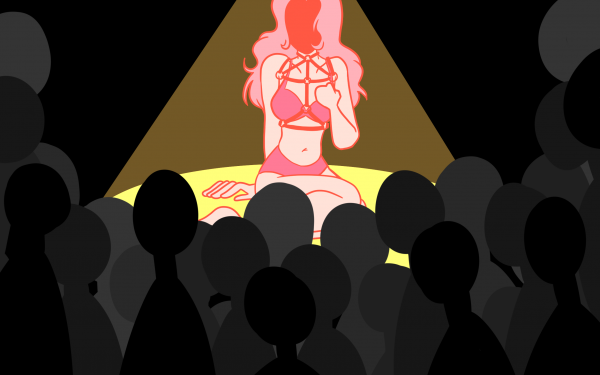Watch Your Language
Women, Ladies and the Weight of Words When It Comes to Gender
In February, Sarah Nicole Prickett, ex- Globe and Mail columnist and freelance journalist, kicked off a minor controversy with the publication of her online article for Vice, officially titled “Where Are All the Women?”
Though someone with a keen editorial mind and probably a sense of propriety changed the headline at some point, the URL for the article still shows what was likely the original title. It ends like this: /im-sick-of-ladies.
The article is a rampaging diatribe, an angst-ridden mess and an absolute joy to read. Prickett’s aim is to divorce the women from the ladies—that is, women who are themselves for their own sake, versus ladies, who maintain a stiff upper lip, vote Democrat and try to appear proper.
“Ladies,” Prickett writes, “can eat me and call it a juice cleanse.”
Unsurprisingly, given her tone and the website it appeared on, the article was the recipient of dozens of comments, often less than friendly in tone—and over 1,000 Facebook likes. But whatever your stance on “the upper echelons of what is called equality,” as Prickett calls the space ladies occupy in society, the article and the reaction to it did bring back to the fore an interesting relationship.
“It felt very much like putting on a suit of clothes,” said Prickett of ‘lady’ when I called her to ask about the article. “Like when you’re a lady, it seems like a very modest dressing. It seems like a sort of space between the fabric and the skin.”
More than just differentiating between girls, tomboys, bitches, women and ladies, however, “Where Are All the Women?” is also a reminder of the power of language when it comes to gender.
If the archetypal caricature of the feminist is a man-hating, non-shaving, bra-burning perma-angry lesbian, her favourite word is almost certainly ‘womyn.’ Though the first recorded use of that spelling was in 1831, womyn really exploded onto the scene in the 1980s.
It spent the next two decades being mocked, however, the urge to cut the word “man” out of “woman” used as an easy signifier of the pettiness and small-mindedness of the feminist movement by its critics.
It’s easy to target people who seem to advocate for intentionally misspelling things as part of an ideological platform, and “womyn” may seem ridiculous divorced from context. But to construe something like “womyn” as merely a spelling question is to miss the point entirely.
On some level, Prickett’s article understands this—that language is an integral, important aspect of gender, and the way it’s policed reflects the nature of gender relations pretty accurately.
The words we use to describe certain groups can be incredibly powerful—racial minorities understand this, sexual minorities understand this; women understand this and transgender people understand it perhaps more so than any.
It’s one thing to call someone a degrading term, but when even the words ‘he’ or ‘she’ feel like a slur, spoken and written words can be a minefield.
As a result, in English, ‘they’ is increasingly gaining traction when it comes to identifying transpeople who prefer that to masculine or feminine pronouns.
In French, however, a language where every noun, no matter how inanimate, is gendered, and where you can’t even refer to a friend without revealing his or her gender, matters are a little trickier. How does one exist outside the binary? Where is the in-between space?
Elaine Kennedy, a Montreal-based translator specializing in French-to-English work, noted that, in French, the relationship between nouns and their gender doesn’t seem founded on anything in particular.
“Basically, in linguistics that relationship, within a language, is considered to be arbitrary,” she said. “Your table and chair? It’s very, very arbitrary.”
When searching to bridge gaps between French texts, which often use masculine pronouns as neutral, Kennedy works to be inclusive.
“One of the problems is then you end up in situations where there are precedents,” she said. “Legal language can be very archaic, so you’re fighting with tradition. What you want is universal. You want something that’s very universal, that applies to everyone who it could apply to.”
Although it was nearly a millennium ago, English used to be a gendered language, but it has moved almost entirely away from that. Kennedy doesn’t see a similar shift occurring any time soon in French, but there has been some progress, she said.
“People will say, ‘les citoyens et les citoyennes,’” she said, using the example of addressing a group of citizens.
“And you see that a lot [with] people who are politically aware, when they are addressing an audience that they know is made up of men and women. There is that awareness in French [now], in addressing people, they don’t just use the traditional masculine to refer to everybody. So that’s been a huge movement.”
Of course, even the act of translation is trapped. In “Gender and the Metaphorics of Translation,” a 1988 essay by Lori Chamberlain, the author discusses the pejorative nickname for translations, “les belles infidèles.”
The term translates as the unfaithful beauties, a misogynist descriptor derived from the fact that in French, a “traduction” is feminine, and the original “texte” is masculine.
German, on the other hand, has a neutral gender, an easy fix for people who shudder at the thought of constructions like “xe” and “xir” to denote gender-indeterminate people.
For Prickett, ultimately, identity is as much about self-determination as anything else. Where there’s a will, there’s a word.
“It’s not entirely about biology, of course it’s not. It’s something elemental, this flesh and blood and bone desire to be a woman”—by which she meant a ‘woman,’ not simply female—“but it doesn’t necessarily have to do with the parts you were born with. It’s something else, like it’s almost like it’s in your blood,” she said.
“Being a woman doesn’t feel like it’s about your vagina.”

ED1(WEB)_816_896_90.jpg)
_600_832_s.png)



_1__600_375_90_s_c1.jpg)
_(1)_600_375_s_c1.png)